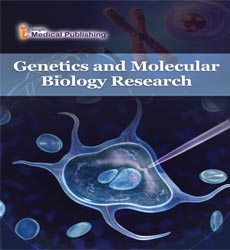Can CRISPR Gene Therapy Technique Cure Sickle Cell Disease: A Future Prospective
Department of Molecular and Cellular Physiology, Calcutta University, India
- Corresponding Author:
- Amit Majumdar
Department of Molecular and Cellular Physiology
Calcutta University, India
E-mail: majumdar.amit@gmail.com
Received Date: August 29, 2021; Accepted Date: September 27, 2021; Published Date: October 03, 2021
Citation: Majumdar A (2021) Can CRISPR Gene Therapy Technique Cure Sickle Cell Disease: A Future Prospective. Genet Mol Biol Res Vol No: 5 Iss No:5:57
Copyright: © 2021 Majumdar A. This is an open-access article distributed under the terms of the Creative Commons Attribution License, which permits unrestricted use, distribution, and reproduction in any medium, provided the original author and source are credited.
Keywords
Sickle cell; CRISPR
Introduction
The infamous Sickle Cell infection may before long have a possible fix to the disease that it brings to people, and it is through quality treatment that specialists are investigating now. CRISPR's Gene Editing innovation with the Cas9 technique has been applied to attempt to battle against sickle cell, something which the specialists have considered to show incredible guarantee.
CRISPR innovation has been amazingly useful in a ton of cases concerning recognizing illness, observing its spread, or in any event, killing it and annihilating it off the body. There have been a few endeavors where CRISPR has been utilized to fix HIV and Leukaemia, two of the most infamous executioners in infection history
CRISPR Technology is approaching a fix and therapy for Sickle Cell Disease, a problem by the qualities in the body delivering the perfect measure of haemoglobin for the body's red platelets. The infection is known to be lethal to its casualties, with a low death rate at 40 years old.
CRISPR Technology is a famous name in the wellbeing tech industry, especially in light of the fact that it handles genome altering and treatment, which is promising on specific sicknesses and diseases. The promising treatment has been imagined to attempt to handle various illnesses and issues that can't be replied or fixed by specific systems generally accessible [1]. The quality altering innovation is incredibly famous as it expects to carry a state of the art way to deal with specific sicknesses, and it handles the "difficult to reach" spaces of medication like qualities or cells.
Sickle cell disease
Red platelets are known to be "circle" moulded cells in the body, and individuals contaminated with Sickle Cell sickness influence its creation and shape into a bow or "sickle." What this implies is that the body can't deliver the perfect measure of haemoglobin for the RBCs, accordingly influencing flow and oxygen dissemination. It influences a ton of substantial capacities, and harm organs harshly, that can prompt an individual's body coming up short before them [2].
Perspective
This quality altering technique can possibly beat these. Cells of a similar patient can be controlled and can be relocated without the danger of dismissal or to cause insusceptible responses from the benefactor (Graft versus-Host sickness).
Trial
Individuals with sickle-cell infection have two faulty haemoglobin qualities in their undifferentiated organisms, one from each parent. Together, the two flawed qualities are what cause red platelets, which are regularly circle moulded and adaptable, to turn out to be hardened and tacky as they mature [3].
Individuals who acquire one flawed quality and one ordinary quality have what is known as sickle-cell characteristic, a condition that affects around 3 million Americans. A large portion of their red platelets are typical, permitting them to have sound existences liberated from sickle-cell infection. Nonetheless, the strange haemoglobin quality in their DNA can be given to their kids.
In the preliminary, they plans to fix and supplant flawed blood foundational microorganisms in patients with sickle-cell infection. The thought is to change the patients into sound individuals with sickle-cell attribute by changing over their faulty undifferentiated organisms with two strange haemoglobin qualities into foundational microorganisms with simply a solitary unusual quality. CRISPR will remove the mutated DNA sequence from one of the genes [4].
When the quality has been fixed, the recently adjusted immature microorganisms with sickle-cell attribute will be infused once again into the patient's circulatory system. Preferably, some will discover their direction into the bone marrow and begin putting out large number of solid red platelets.
References
- Demirci S, Leonard A, Mora JJH, Uchida N, Tisdale JF (2019) CRISPR/Cas9 for Sickle Cell Disease: Applications, Future Possibilities, and Challenges. Adv Exp Med Biol 1144: 37-52.
- Park SH, Bao G (2021) CRISPR/Cas9 gene editing for curing sickle cell disease. Transfus Apher Sci 60(1): 103060.
- Frangoul H, Altshuler D, Cappellini MD, Chen YS, Domm J, et al. (2021) CRISPR-Cas9 Gene Editing for Sickle Cell Disease and β-Thalassemia. N Engl J Med 384(3): 252-260.
- Bundy DG, Strouse JJ, Casella JF, Miller MR (2010) Burden of influenza-related hospitalizations among children with sickle cell disease. Pediatrics 2010: 125:234–43.
Open Access Journals
- Aquaculture & Veterinary Science
- Chemistry & Chemical Sciences
- Clinical Sciences
- Engineering
- General Science
- Genetics & Molecular Biology
- Health Care & Nursing
- Immunology & Microbiology
- Materials Science
- Mathematics & Physics
- Medical Sciences
- Neurology & Psychiatry
- Oncology & Cancer Science
- Pharmaceutical Sciences
